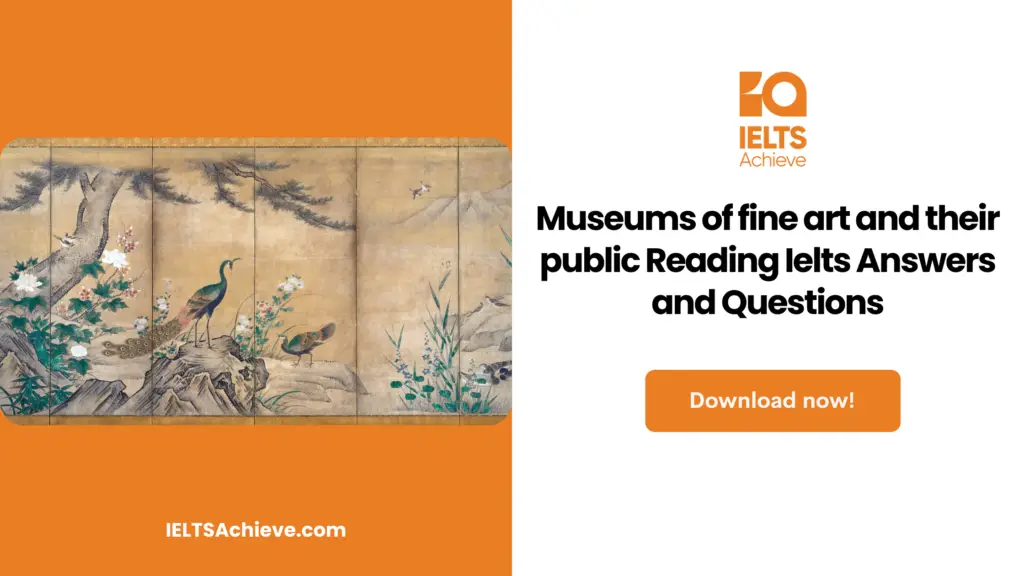The Blog post contains the following IELTS Reading Questions:
- IELTS reading summary completion
- IELTS reading multiple choice questions
- IELTS reading yes no not given
Stay informed and prepared for success – Explore our comprehensive Reading Test Info page to get valuable insights, exam format details, and expert tips for mastering the IELTS Reading section.
IELTS Reading Passage: Museums of fine art and their public

Museums of fine art and their public
The fact that tourists flock to the Louvre to view the original Mona Lisa despite the ease with which they can view a reproduction elsewhere makes us rethink the purpose of art museums in the modern world.
The Mona Lisa by Leonardo da Vinci is one of the most well-known works of art in history. The vast majority of visitors will have seen copies of the work before, but they understand that the experience of viewing a masterpiece in its original form is unparalleled.
Nonetheless, if Mona Lisa were a best-selling book, not many readers would visit a museum to peruse the author’s original manuscript rather than a reproduction. Oil paintings have always been created as one-of-a-kind pieces of art, while the novel has flourished due to technological advancements that have allowed for the mass production of texts. Furthermore, it could be argued that the conventions for interpreting or “reading” each medium vary. When reading a novel, the reader focuses on the meaning of the words rather than how they are printed on the page, but when looking at a painting, the ‘reader’ must pay equal attention to the material form of the marks and shapes on the canvas as to the ideas they may signify.
But copies of virtually any masterpiece have always been possible, and they tend to be remarkably faithful. Artists in the 16th century appeared content to delegate the reproduction of their creations to their workshop apprentices as regular “bread and butter” work, as evidenced by the seven surviving versions of the Mona Lisa. Today’s reprographic techniques make it possible to create prints that are accurate to the original in terms of size, color, and even the painting’s surface relief, making the task of reproducing artwork much easier and more trustworthy than in the past.
Museums continue to advocate for the unique status of original work, despite an underlying recognition that disseminating good reproductions can be culturally valuable. Unfortunately, it appears that this severely restricts the type of experience that can be provided to guests.
The museum’s presentation of the exhibits is a drawback. Many people refer to art museums as “treasure houses” because of the rare and priceless works of art and other historical artifacts they store. The presence of guards, attendants, ropes, and display cases designed to keep us away from the exhibits serves as a constant reminder of this fact even before we view a collection. The building’s design can be a major contributor to this impression in many cases. Furthermore, the National Gallery in London houses a massive collection spread across many rooms, each containing dozens of works, any one of which is likely to be worth more than all that the average visitor possesses. It’s tough to feel good about oneself in a society that uses material wealth as a proxy for one’s social standing.
Thinking about the ‘value’ of the original work in the context of a treasure house reinforces the idea that someone or something much more powerful than the viewer has placed a high monetary value on these works ever since they were created. Since the viewer’s interpretation won’t change the work’s value, they don’t bother trying to give it the kind of immediate, intuitive interpretation with which the work was originally met.
The oddity of seeing paintings, drawings, and sculptures that were never meant to be seen together in one place may then strike the viewer. The sheer number of displays amplifies this ‘displacement effect’. It’s likely that there are far more pieces on display at a major museum than we could possibly see in a matter of weeks or months.
This is especially upsetting because the passing of time appears to be an essential component in appreciating all forms of art. When compared to other forms of art, paintings stand out due to the fact that there is no set amount of time during which they should be viewed. In contrast, operas and plays rely on audience participation for the duration of the performance. The reading of novels and poems also follows a specific order in time, but there is no obvious beginning or end to an image. Because of this, we tend to look at works of art on a surface level, rather than recognizing the depth of effort and detail that went into creating them.
So, the art historian’s perspective—a subfield of academia concerned with ‘discovering the meaning’ of art in relation to contemporary culture—becomes the standard for critical analysis. It’s a perfect fit with the museum’s mission because the method actively seeks out and preserves “authentic,” or first-hand interpretations of the displays. Again, this seems to end the impromptu, participatory criticism that is common in literary criticism but rare in art history.
What happens to critical practices when spontaneous criticism is stifled is on display in museums. The general public at museums, like any other audience, benefits more from art when they feel comfortable sharing their thoughts on it. In the same way that literature and music have been made permanently accessible to the public through high-fidelity reproductions, appropriate works of fine art could be made permanently accessible to the public. It’s possible that asking that of those who seek to preserve and control the art establishment is too much to expect.
Unlock your full potential in the IELTS Reading section – Visit our IELTS Reading Practice Question Answer page now!
Recommended Questions:
Renewable Energy IELTS Reading Question with Answer
Museums of fine art and their public IELTS Reading Questions
Questions 1-5
Complete the summary using the list of words, A-L, below. Write the correct letter, A-L, in boxes 1-5 on your answer sheet.
The value attached to original works of art
People visit museums in order to appreciate an original piece of art, and this is why museums attract such large crowds. But they don’t visit libraries and archives to read rare copies of novels, possibly because the widespread distribution of novels has historically relied on 1.___________ because novels take so long to read and because the 2.__________ are crucial to the success of any novel. Artists like Leonardo, however, were happy to teach 3.__________ in the past to make copies of their work, and modern methods of reproduction allow for spot-on copies of surface relief features, color, and 4.___________. It is disappointing that museums continue to promote the superiority of original pieces of art, as this may not be in the best interests of 5.____________. List of Words:
- Artist
- Standard Technology
- Assistants
- Underlying concepts
- Readers
- Institution
- Picture Frames
- Public
- Mass production
- Paints
- Size
- Mechanical Operations
Boost your performance in Summary, Notes, Table, and Flowchart Completion tasks. Click here to explore our detailed guide and learn how to effectively complete summaries, notes, tables, and flowcharts in the IELTS Reading section.
Questions 6-9
Choose the correct letter, A, B, C, or D. Write the correct letter in boxes 6-9 on your answer sheet
6. The author claims that the visitor experiences a “displacement effect” because of
- the importance of prioritizing people’s well-being over grand artistic projects
- Visitors’ Self-Esteem May Take a Hit At The Museum
- the potential for societal strife between commercial and creative pursuits
- the unfavorable effect on a country’s budget caused by its pursuit of a world-class art collection.
7. However, the author argues that painting stands apart from other art forms in that it
- They disregard their own emotional response as inconsequential
- They are completely oblivious to the worth of the work
- People are worried about the potential financial repercussions
- They don’t know enough to have an informed opinion
8. The author uses the National Gallery in London as an example because
- Bad tastes in the pieces chosen for display
- the lack of exceptional works and the general sameness of the paintings
- the inaccessibility of certain artworks over a prolonged period of time
- the range and arrangement of the works on display.
9. The author argues that modern audiences are less likely to criticize a work of art
- contains a definite beginning and/or end
- requires the assistance of experts outside the scope of the current project
- needs a fixed venue in order to perform
- require talking to a group of people
Ready to improve your performance in Multiple Choice Questions (MCQs)? Click here to access our comprehensive guide on how to tackle MCQs effectively in the IELTS Reading section.
Questions 10-14
Do the following statements agree with the views of the writer in Reading Passage? In boxes 10-14 on your answer sheet, write
YES if the statement agrees with the views of the writer
NO if the statement contradicts the views of the writer
NOT GIVEN if the is impossible to say what the writer thinks about this
10. Only high-quality reproductions of works of art should be made available for purchase by the general public.
11. Those in positions of influence in the future will likely push for a wider appreciation of the arts.
12. Inviting open discussion about art is important.
13. The goal of studying art history should be to understand art through various lenses.
14. Art historians take a different approach than museums, which often causes friction.
Want to excel in identifying the writer’s views and claims? Click here to explore our in-depth guide on how to accurately determine Yes, No, or Not Given in the IELTS Reading section.
Unlock your full potential in the IELTS Reading section – Visit our IELTS Reading Practice Question Answer page now!
Recommended Questions:
Renewable Energy IELTS Reading Question with Answer
Museums of fine art and their public Reading Answers
1. I
2. D
3. C
4. K
5. H
6. D
7. A
8. B
9. A
10. Not given
11. No
12. Yes
13. Not given
14. No

We hope you found this post useful in helping you to study for the IELTS Test. If you have any questions please let us know in the comments below or on the Facebook page.
The best way to keep up to date with posts like this is to like us on Facebook, then follow us on Instagram and Pinterest. If you need help preparing for the IELTS Test, join the IELTS Achieve Academy and see how we can assist you to achieve your desired band score. We offer an essay correction service, mock exams and online courses.

